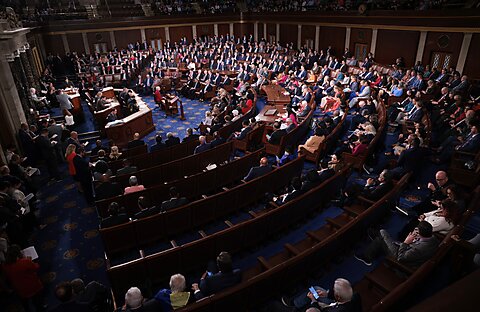
Jeffrey A. Singer
It’s a sad irony that, on December 12, the same day that the Senate Health, Education, Labor, and Pensions (HELP) Committee passed the Modernizing Opioid Treatment Access Act (MOTAA) by a vote of 16–5—the first serious attempt in decades to expand access to treatment for Opioid Use Disorder—the House of Representatives went in the opposite direction, passing the Combat Illicit Xylazine Act (H.R. 4531) 386–37—an utterly unserious attempt to resist the Iron Law of Prohibition.
As I wrote here, the veterinary tranquilizer xylazine, which people who use drugs call tranq, is being added to illicit fentanyl that is smuggled into the country and sold on the black market. It is also mixed with other illegal drugs, such as cocaine and methamphetamine. The sedative properties of the drug greatly enhance the narcotic effects of opioids. That enhancement is why xylazine is the most recent manifestation of the Iron Law of Prohibition: the harder the enforcement, the harder the drugs. Prohibition incentivizes drug cartels to develop more potent drugs and drug combinations that are easier to smuggle in smaller sizes and subdivide into a greater number of units to sell.
Toxicology studies have found xylazine mixed with illicit drugs starting in the early 2000s. In 2012, researchers at the University of Puerto Rico reported it was being mixed with heroin and cocaine. Lately, it has been detected more frequently throughout North America, including Canada.
The Drug Enforcement Administration reported it found xylazine in 23 percent of fentanyl powder and 7 percent of fentanyl pills the agency seized in 2022.
The drug is a muscle relaxant and sedative often used in veterinary anesthesia. It has strong alpha‐adrenergic properties, which cause constriction of the blood vessels. These vasoconstrictive properties dramatically reduce the blood supply to the soft tissues near the injection site, often causing the tissue to die and infected ulcerations on the users’ limbs. Sometimes, the infections are severe enough to require life‐saving amputation.
While xylazine users can develop a physical dependency, the drug is more dangerous because the opioid overdose antidote naloxone does not reverse the respiratory depression seen with xylazine overdoses.
Rather than accept reality, the House of Representatives thinks it can combat xylazine by adding it to the DEA’s list of controlled substances. Xylazine is not currently on that list. The Combat Illicit Xylazine Act bypasses the usual process by which cops practice medicine. Ordinarily, the DEA asks the Department of Health and Human Services to undertake an 8‑step process to evaluate the risks and therapeutic potential of a drug before adding it to its list of controlled substances. The results of these studies inform lawmakers on formulating penalties for those who make, sell, or use these drugs non‐medically.
This time, however, lawmakers decided that politicians know even more than cops about how to practice medicine. They dispensed with the formalities, deciding they knew enough about xylazine without any research to determine where the drug belonged on the list. They decided xylazine belongs on Schedule III: “drugs with a moderate to low potential for physical and psychological dependence.”
Anabolic steroids, testosterone, acetaminophen with codeine, and ketamine are some examples of Schedule III drugs.
The bill imposes criminal penalties of up to 15 years in prison plus fines for people caught possessing, selling, manufacturing, or transporting xylazine outside of the legal prescription drug market.
For some inexplicable reason, lawmakers believe that adding xylazine to the DEA list of controlled substances and threatening prison sentences will deter cartels and drug users. Heroin and marijuana have been listed as Schedule 1—“no currently accepted medical use and high potential for abuse”—for half a century. The only thing it accomplished was to fill our prisons, mostly with non‐violent and low‐level drug offenders, while heroin overdoses soared—until the cartels discovered that fentanyl is more potent and easier to smuggle than heroin. Then fentanyl smuggling overtook heroin.
The House passing the Combat Illicit Xylazine Act demonstrates that lawmakers are still not serious about addressing the overdose crisis. Either that, or they are in denial about the real reason why xylazine is being added to fentanyl and other drugs on the black market: prohibition.
If lawmakers want to get serious about reducing overdose deaths, they should make it easier for drug users and organizations that want to save their lives to engage in harm reduction. For example, Congress can repeal or amend 21 U.S.C. Section 856, the so‐called “crack house” statute, so community organizations can open overdose prevention centers (OPCs), which have been saving lives in 16 countries and 147 locations since the 1980s. The “crack house” statute bans them in this country.
States can repeal laws that make drug testing equipment illegal drug paraphernalia, criminalizing people for helping people who use drugs test to see if they are adulterated with fentanyl, xylazine, or other substances. The same Canadian company that manufactures fentanyl test strips now makes xylazine test strips. Harm reduction organizations can distribute them along with fentanyl test strips to nonmedical users in states where drug paraphernalia laws don’t stand in the way.
The Combat Illicit Xylazine Act is worse than political theater. By denying reality and deferring any meaningful reform, lawmakers are a part of the overdose problem.





